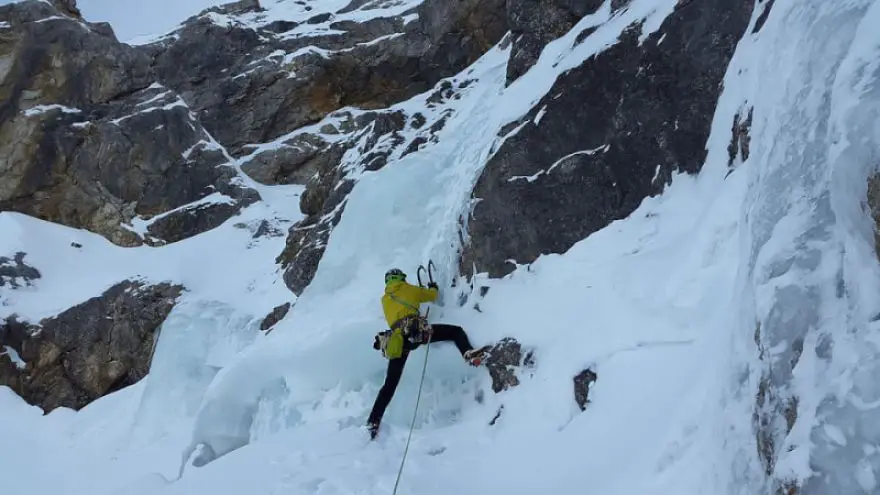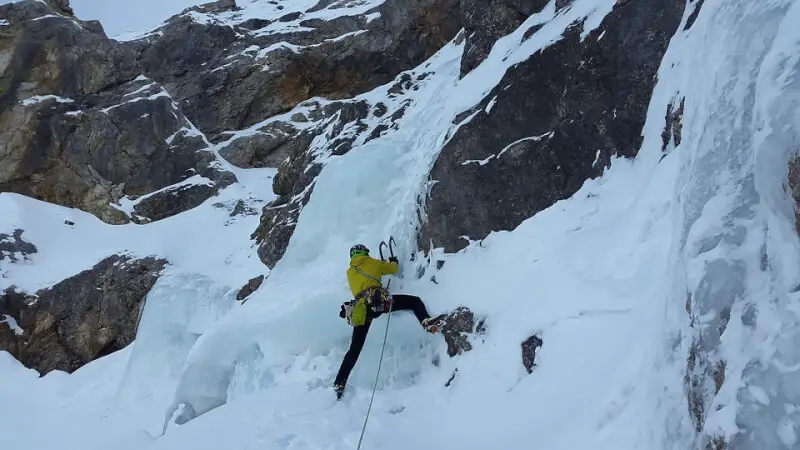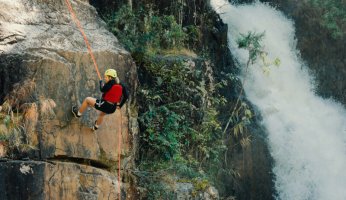Explaining the Ice Climbing Grading System
 Explaining the Ice Climbing Grading System
gearweare.net
Explaining the Ice Climbing Grading System
gearweare.net
As we move deeper into winter the allure of ice climbing increases. This sport involves climbing vertical ice with ice tools and crampons, and can only be done during the coldest parts of the year when the ice has hardened to a thickness that allows for greater stability and ease of movement. The colder months are also the prime time of year for mixed climbing, which involves climbing over both rock and ice with the same tools used when ice climbing.
Similarly to roped climbing and bouldering there are grading systems that are used to measure the difficulty of the different ice and mixed climbs that one may want to do. Gaining an understanding of these systems is an important first step for those who want to learn to ice climb because the difficulty between the easiest and hardest ice climbs vary dramatically. Without knowing how to read the grades one may get on something that looks easy from the ground but is actually far beyond their skill level.
The Changing Nature of Ice (Grades)
Ice climbing grades are complicated because there are so many different ways that they are measured around the world. Even within the United States, there is more than one way that ice climbs are graded. These differences in grading are typically locational, meaning that they are used within specific areas of the country but not elsewhere. Still, there are a few standard systems, which this article will pay the most attention to.
Another reason why grading ice climbs are complicated is that, unlike rock, ice is constantly shifting and changing. For this reason, steepness and technical difficulty are the primary factors used to discern how difficult an ice climb will be.

The Most Common System – Water Ice and Alpine Ice Grades
The most commonly used ice climbing system in the United States grades climbs using numbers 1 through 7, although it is very likely that other numbers will be added as the sport continues to be pushed. Both ice climbing and alpine climbing use this system. To connotate which of these two types of climbing a route actually is, letters are added before the number. “WI”, which stand for “water ice”, means that the climb will ascend seasonal ice that is frozen water, while “AI”, which stands for “alpine ice”, means this will be a climb that ascends mountains in the alpine zone and may traverse ice that never melts.
The number a climb is assigned takes into account a number of factors, including how accessible the climb is, how long the climb is, how steep the climb is, and how dangerous the climb may be. Multi-pitch climbs and climbs that may take multiple days will, therefore, be assigned tougher grades even if they aren’t particularly steep. Conversely, an extremely steep ice climb that requires a high level of technical skill may also receive a harder grade even if it is only one or two pitches in length. Because alpine climbs tend to take longer and gain more altitude, those that are the same grade as an ice climb may technically be easier.
According to the American Alpine Club the way that grades on ice climbs are assigned can be broken down as follows:
- WI 1 – Low angle climb that is easy to get to from a vehicle.
- WI 2 – The angle remains around 60°, with some bulges possible, and the climb is able to be easily protected.
- WI 3 – The angle remains around 70°, with areas of steepness between 80° and 90°. The climb has rests and good protection.
- WI 4 – The climb includes multiple pitches at 80° or long sections of 90° ice with rests in between.
- WI 5 – Long, rope length sections of 85° to 90° ice or shorter climbs on bad ice that is difficult to protect.
- WI 6 – The climb includes long sections of sustained 90° climbing or ice that is even poorer and harder to protect than that of WI 5.
- WI 7 – As difficult as the climbing that falls within the previous grade, but on poor quality ice that is difficult or impossible to protect.
Mixed Route Climbing Grades.
Since climbing a mixed route involves ice as well as rock and utilizes ice tools with a technique called “dry tooling” it is important to mention the grading system used to measure difficulty with this style of climbing as well. Similarly to the system outlined above, mixed rout grades utilize a letter and a number as well. The letter is “M”, which stands for “mixed”, and the numbers range from 1 to 13, although the upper limits of mixed climbing continue to be pushed. Overall M1-M3 is extremely easy climbing, M4-M6 is low moderate climbing, M7-M9 is high moderate climbing, and anything above M10 is advanced climbing. A handy breakdown of the difficulty of mixed rout grades, which compares them to the Yosemite Decimal System, can be found here.
Other Systems for Grading Ice Climbs
As mentioned earlier there are lots of other systems for measuring the difficulty of ice climbs around the world. In the United States, for example, the NE Ice systems are used in New England but nowhere else. This system is similar to the more common ice climbing grading system outlined above but uses the letters “NEI” and grades climbs on a scale from 1 to 5.
Some other systems that one may encounter the Alaska Grades, the Scottish Winter Grades, and the Canadian Winter Commitment Grades. A full breakdown of how these other systems work can be found here.












